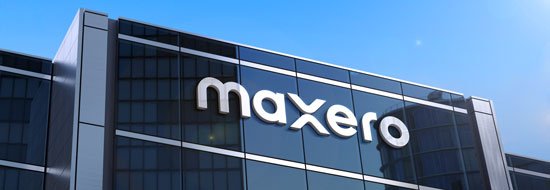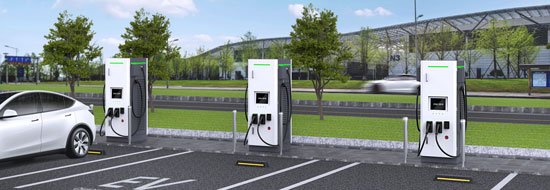
Calaveras County has a total of 21 EV charging ports across six locations. This Tesla Supercharger located in Jackson is the closest option for some Calaveras residents. Marie-Elena Schembri/Calaveras Enterprise
In January, President Joe Biden announced the disbursement of nearly $150 million to 24 grant recipients across the country to bring 4,500 existing electric vehicle (EV) charging ports up to par and improve the reliability of EV charging.
This grant is funded through a new federal grant program, the National Electric Vehicle Infrastructure (NEVI) Formula Program, under the Biden administration’s Bipartisan Infrastructure Law. The Bipartisan Infrastructure Law aims to invest $550 billion in updating the nation’s infrastructure, including roads, bridges, mass transit, water infrastructure, and broadband, and is, according to the U.S. Department of Transportation, “the largest long-term investment in our infrastructure and economy in our nation’s history.”
NEVI is “a $5 billion program administered by the Federal Highway Administration (FHWA) and supported by the Joint Office of Energy and Transportation to help states build out EV charging,” according to a Jan. 18 press release.
The California Department of Transportation received the largest grant of all 24 recipients, at $63.7 million, with an estimated 1,302 EV ports in need of repair or replacement.
Another grant program, also announced in January, awarded $623 million, funded through the Bipartisan Infrastructure Law’s $2.5 billion Charging and Fueling Infrastructure (CFI) Discretionary Grant Program, to construct approximately 7,500 EV charging ports in 22 states and Puerto Rico. Of the 47 projects awarded, 10 are located in California, including two projects in the San Joaquin Valley and others in the Bay Area, Los Angeles, and Northern and Southern California.
The projects in San Joaquin Valley will fund the construction of freight truck charging sites in Taft and Gustine (San Joaquin Valley Unified Air Pollution Control District, $56 million) and the construction of 74 new Level-2 and 40 DC fast chargers at 20 locations throughout the county (San Joaquin County, $15 million).
Three hundred and eleven million dollars will go to 36 community-based projects, while $312 million in funding will go to 11 “corridor” recipients whose projects are located along roadways designated as alternative fuel corridors.
These “corridors” are a network of highways designated by the U.S. Department of Transportation Federal Highway Administration (FHWA) that include infrastructure for EV charging and hydrogen, propane, and natural gas fueling. While no alternative fuel corridors currently travel through Calaveras County, the state of California has recommended that a section of Highway 4 be designated, which would allow the county government or other eligible groups to apply for funding opportunities currently restricted to projects along these corridors.
In the state’s deployment plan for the National Electric Vehicle Infrastructure Program 2023 annual update, the latest round of nominations included highway segments with “emphasis on rural, disadvantaged, and tribal regions within California.” Recommended was an 8-mile section of Highway 49 in Amador County, from Highway 16 near Plymouth to Highway 88 in Jackson. Among a prior round of recommendations was a 55-mile section of Highway 4 from the Port of Stockton Expressway in Stockton to Angels Camp.
Both corridors are still “pending,” as they do not currently have enough charging stations to meet the requirements (distance between ports, number, and type of ports available) to qualify for the purposes of NEVI funding.
Local EV travel and ease of charging
While there are currently no alternative fuel corridors within Calaveras County, there are some EV charging stations, with more on the way. Unfortunately for drivers of electric vehicles in Calaveras County, the charging stations are often separated by dozens of miles, which can make long commutes and traveling difficult.
Tesla owner Salvador Sanchez Hernandez from Rail Road Flat, who manages properties in the area and also out of the county, carefully plans his travel routes and monitors his battery usage to make sure he doesn’t get caught without any power.
Only once in four years of owning his electric vehicle has he run out of juice, and he luckily was able to make it to a location where he could plug in and call for a ride to get his other fuel-generated vehicle. It helps that he has chargers installed at both his home in Rail Road Flat and business in Glencoe, so that he can maintain adequate charge levels throughout the day, even when he has a lot of driving to do.
He was able to get a grant from the Oakland nonprofit, GRID Alternatives, to cover the cost of updating his electric panel and installing a level 2 (240V AC) charger at his home. Level 2 chargers may require permits from the county and should be installed by a licensed electrician.
Electric vehicles can also be charged with a regular residential 120V outlet (level 1), but there is a big difference in efficiency.
Using the level 2 charger, it takes six hours for Sanchez Hernandez’s Tesla to charge to 100% at home, while charging at level 1 could take up to 30 hours for some battery models.
He charges overnight when electric rates are the lowest and said that, according to the Tesla mobile app, which calculates his usage and monitors the battery level, he has spent $1,317 on charging his Tesla since March of last year, a cost savings of $2,843 over what he would have spent on gas for the same amount of mileage.
Occasionally, while traveling longer distances, he will stop to recharge at public charging stations, but only charge as much as he needs to get to his next destination. That way, he doesn’t pay as much for charging on the go and does the majority of charging at his office or home, where the cost is lower.
“So tomorrow I have to drive to Folsom, Shingle Springs area because I have an apartment complex over there, and what I do is try to charge enough, but I have to stop right now because of the weather, because right now it’s winter, and the batteries don’t last as long as they do in the summer. So I stop at Mel’s diner right there in Jackson, and I charge. I get like a 10% charge, and it costs me $1.60. I think that’s how much it cost me last time, and that’s enough to get me home,” Sanchez Hernandez explained.
He uses an app, called PlugShare, to locate chargers along his route. The app makes it easier to plan, but it doesn’t always work out. When Sanchez Hernandez ended up stranded before, it was because he had planned on charging up at a station in front of Sunrise Pharmacy in Valley Springs, but when he got there, it was not turned on.
The station is not currently listed as an active public charging station, and there are no others in the area. There are active chargers listed in Copperopolis, Angels Camp, Murphys, and Arnold. According to data from the California Energy Commission, there are 21 public chargers in the county, nine of which are level 2 and 12 of which are DC fast chargers. A new Tesla Supercharger station with eight charging ports is currently under construction in Arnold.
For West Point resident Stacie Link, going fully electric didn’t make sense.
“I specifically didn’t go to an all-electric car because I have in the past used an electric car, and the lack of charging was monumental,” she said.
She purchased her hybrid Subaru Crosstrek one year ago this month and only charges it at her home, which runs on solar power. She uses a regular household 120V outlet, which takes about eight hours to charge.
“I don’t plug in anywhere else because it’s just very inconvenient,” Link said. “It’s just not practical anywhere else.”
Like Sanchez Hernandez, Link strategizes to optimize the miles she can get from her electric battery. Link said she uses gasoline during her morning commute to San Andreas, where she works, and switches to electric when she gets to “flat ground.” She also uses gas when traveling to places like Reno or Lake Tahoe because altitude impacts the battery’s efficiency.
“Anytime there’s a climb involved, it’s not worth using the battery,” Link said.
Link said she is happy with her hybrid and doesn’t have plans to go back to a conventional car, though she wishes “it got a little bit further on the battery than it does.” Overall, Link recommends hybrid vehicles over solely electric vehicles for those living in Calaveras County because of the lack of charging stations.
She also said that she is thinking about getting a new truck but “will not go electric” on that purchase.
EV charging stations
Residents or visitors to Calaveras County can charge their hybrid and electric vehicles at the following public locations:
Arnold Cruisers Gas Station
1297 Highway 4, Arnold
2 ports: CHAdeMO and CSS/SAE DC
Fast Charge
Courtwood Inn, Tesla Destination
2081 Ponderosa Way, Murphys
2 ports, level 2
• Victoria Inn, Tesla Destination
402 Main St., Murphys
2 ports, level 2
• Dunbar House 1880, Tesla Destination
271 Jones St., Murphys
3 ports, level 2
• WorldMark by Wyndham-Angels
Camp
123 Selkirk Ranch Road, Angels Camp
2 ports, level 2
• Copperopolis Town Square, Tesla
Supercharger
100 Town Square Road, Copperopolis
12 ports, DC Fast
Nearby:
• Bear Valley Lodge, Tesla Destination
3 Bear Valley Road, Bear Valley
2 ports, level 2
• Holiday Inn Express, ChargePoint
Charging Station
1101 Clinton Road, Jackson
2 ports, level 2
• Mel’s Diner, Tesla Supercharger
31 Highway 88, Jackson
8 ports, DC Fast
• Jackson Rancheria Casino Resort, Tesla
Destination
12222 New York Ranch Road
1 port, level 2
• Columbia College, Lower Parking
11600 Columbia College Drive, Sonora
2 ports, level 2
Sunrise Hills Commercial Association
975 Morning Star Drive, Sonora
4 ports, level 2
• Adventist Health Sonora, ChargePoint
Charging Station
900 Greenley Road, Sonora
2 ports, level 2
• The Inn at Locke House, Tesla
Destination
19960 N. Elliott Road, Lockeford
1 port, level 2
[ad_2]
Source link




